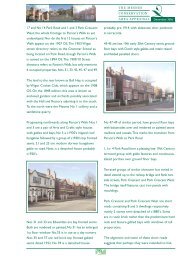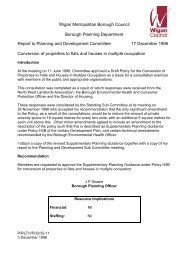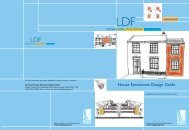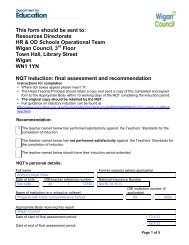Character Type 4: Wetlands and flashes (.pdf ... - Wigan Council
Character Type 4: Wetlands and flashes (.pdf ... - Wigan Council
Character Type 4: Wetlands and flashes (.pdf ... - Wigan Council
You also want an ePaper? Increase the reach of your titles
YUMPU automatically turns print PDFs into web optimized ePapers that Google loves.
CHARACTER TYPE 4<br />
WETLANDS AND FLASHES<br />
Description<br />
Numerous areas of wetl<strong>and</strong> <strong>and</strong> open water known as ‘Flashes’ occupy a central corridor of<br />
l<strong>and</strong> associated with low-lying areas within the ‘Makerfield Basin’. They tend to be located to<br />
either side of the Leeds <strong>and</strong> Liverpool Canal <strong>and</strong> Hey Brook, running in a north/west<br />
south/east direction <strong>and</strong> only interrupted by dense urban areas in the centre of <strong>Wigan</strong>. The<br />
larger water bodies include the <strong>Wigan</strong> Flashes <strong>and</strong> Pennington Flash, where subsidence<br />
lakes have formed, inundating former agricultural l<strong>and</strong>. Most of the <strong>flashes</strong> <strong>and</strong> wetl<strong>and</strong><br />
areas have been created by mining subsidence <strong>and</strong> have now become naturalised by<br />
marginal <strong>and</strong> aquatic plants forming important wildlife habitats.<br />
The Leeds <strong>and</strong> Liverpool Canal together with various roads <strong>and</strong> railway lines traverse the<br />
area on embankments, often formed from colliery spoil <strong>and</strong> colonised by pioneer species<br />
such as birch <strong>and</strong> goat willow. These provide good views of the open water.<br />
Although historically a degraded l<strong>and</strong>scape, adversely affected by mining, these areas have<br />
now recovered through both plant re-colonisation <strong>and</strong> restoration to form an attractive <strong>and</strong><br />
important habitat which traverses the Greenheart Regional Park at the core of the Borough.<br />
Many of the wetl<strong>and</strong>s now appear to be completely natural in origin.<br />
Photo 130 Pearson’s Flash.<br />
Views are essentially linear along the corridor of low-lying l<strong>and</strong>. In places the visual corridor<br />
is reduced due to the proximity of raised embankments, but in other locations, such as along<br />
the Leeds <strong>and</strong> Liverpool Canal towpath, views are from an elevated position on an<br />
embankment.<br />
<strong>Character</strong> <strong>Type</strong> 4 – <strong>Wetl<strong>and</strong>s</strong> <strong>and</strong> Flashes<br />
<strong>Wigan</strong> <strong>Council</strong> LCA<br />
168
The <strong>Wigan</strong> wetl<strong>and</strong>s form an important inter-linked wildlife corridor, together with recreational<br />
resources from Westwood Flash in the north, along the Hey Brook Corridor <strong>and</strong> Abram<br />
Flashes towards Pennington Flash. <strong>Wigan</strong> Flashes have been designated as a local nature<br />
reserve <strong>and</strong> contain a major Site of Special Scientific Interest at Ince Moss, together with 7<br />
Sites of Biological Importance. In addition, the Abram Flashes are also designated as SSSIs<br />
<strong>and</strong> Pennington Flash an SBI <strong>and</strong> Country Park. Some formal recreational activities take<br />
place on Scotman’s <strong>and</strong> Pennington Flashes, including sailing <strong>and</strong> canoeing, <strong>and</strong> others<br />
such as fishing, cycling, walking <strong>and</strong> nature study. Together these areas form part of the<br />
<strong>Wigan</strong> Greenheart Regional Park, bringing together sites across <strong>Wigan</strong>’s core countryside to<br />
provide a diverse range of recreational facilities <strong>and</strong> wildlife habitats within a countryside<br />
setting.<br />
Key <strong>Character</strong>istics:<br />
• Low lying, flat, wet meadow, marsh <strong>and</strong> open water<br />
• L<strong>and</strong>scape created from mining subsidence <strong>and</strong> inundation<br />
• L<strong>and</strong>scapes of natural re-colonisation <strong>and</strong>/or restoration<br />
• Occupying linear areas mainly associated with the Leeds <strong>and</strong> Liverpool Canal <strong>and</strong><br />
Hey Brook Corridor<br />
• Nationally <strong>and</strong> regionally important both for wildlife <strong>and</strong> recreation<br />
• Meadowl<strong>and</strong> <strong>and</strong> extensive reed beds associated with Hey Brook<br />
• Wooded areas restricted <strong>and</strong> confined to naturally regenerated ‘carr’ woodl<strong>and</strong><br />
• Views tend to be restricted <strong>and</strong> internal to the wetl<strong>and</strong> corridors<br />
• Sharply defined boundaries to adjoining areas<br />
• Raised embankments to the Leeds <strong>and</strong> Liverpool Canal <strong>and</strong> to road <strong>and</strong> rail<br />
crossings<br />
• Lack of structural l<strong>and</strong>scape ‘feeds’ into the area<br />
• Connections with industrial heritage<br />
<strong>Character</strong> <strong>Type</strong> 4 – <strong>Wetl<strong>and</strong>s</strong> <strong>and</strong> Flashes<br />
169<br />
<strong>Wigan</strong> <strong>Council</strong> LCA
<strong>Character</strong> <strong>Type</strong> 4 – <strong>Wetl<strong>and</strong>s</strong> <strong>and</strong> Flashes<br />
170<br />
<strong>Wigan</strong> <strong>Council</strong> LCA
Cultural History<br />
The low lying area known as the Makerfield Basin is drained to the north-west by the River<br />
Douglas <strong>and</strong> to the south-east by Hey Brook. It has historically been associated with<br />
mossl<strong>and</strong> <strong>and</strong> wet meadow l<strong>and</strong> with the Ince Mosses forming extensive areas of peat bog<br />
before the end of the C19th.<br />
Hey Brook originally flowed through the low-lying l<strong>and</strong> <strong>and</strong> was liable to flooding. Extensive<br />
river meadows ran along either side of the stream, together with a chain of moated sites,<br />
including Abram Hall, Lightshaw Hall (both still st<strong>and</strong>ing), Mossley Hall, Urmstons in the<br />
Meadows <strong>and</strong> Hopecarr Hall.<br />
The construction of the Leeds <strong>and</strong> Liverpool Canal <strong>and</strong> its linkage to the Bridgewater Canal<br />
in 1820 transformed the area. This enabled coal to be exported from the area on a large<br />
scale to the major industrial cities adjacent <strong>and</strong> collieries sprang up all the way along its<br />
course through the <strong>Wigan</strong> coalfield. This resulted in massive areas of underground colliery<br />
workings <strong>and</strong> subsequent large-scale subsidence of the surrounding l<strong>and</strong> as mines began to<br />
collapse when coal had been extracted from the seams below.<br />
Photo. 98 Gerrard’s Bridge.<br />
The <strong>flashes</strong> were created as the collapsed ground levels were inundated by Hey Brook <strong>and</strong><br />
by the residual water in Ince Mosses. The majority of the <strong>flashes</strong> seem to have appeared<br />
during the C20th.<br />
<strong>Character</strong> <strong>Type</strong> 4 – <strong>Wetl<strong>and</strong>s</strong> <strong>and</strong> Flashes<br />
171<br />
<strong>Wigan</strong> <strong>Council</strong> LCA
One of the consequences of the subsidence was that first the Leeds <strong>and</strong> Liverpool Canal <strong>and</strong><br />
then the railway lines through the area also began to subside with potentially disastrous<br />
consequences. To counter this, embankments were raised using colliery spoil <strong>and</strong> over time<br />
these became substantial l<strong>and</strong>scape features.<br />
The <strong>flashes</strong> were also useful dumping grounds for the colliery spoil extracted from beneath<br />
them as well as other materials, such as ash from the Westwood Power Station. In the case<br />
of Ince Mosses this has produced a range of differing habitats. Across the area habitats<br />
include open water, reedbed, fen, rough grassl<strong>and</strong>, wet meadow <strong>and</strong> carr woodl<strong>and</strong>. These<br />
areas are particularly important for a diverse range of flora, invertebrates, bats <strong>and</strong> bird<br />
species – notably water fowl <strong>and</strong> the nationally rare Bittern.<br />
Key cultural elements in the l<strong>and</strong>scape:<br />
• Construction of the Leeds <strong>and</strong> Liverpool Canal<br />
• Construction of various railway routes, some mineral <strong>and</strong> some main line<br />
• Extremely valuable <strong>and</strong> often rare habitats<br />
<strong>Character</strong> <strong>Type</strong> 4 – <strong>Wetl<strong>and</strong>s</strong> <strong>and</strong> Flashes<br />
172<br />
<strong>Wigan</strong> <strong>Council</strong> LCA
AREA 4.A<br />
APPLEY BRIDGE TO MARTLAND MILL<br />
Description<br />
Area A comprises the Douglas Valley floodplain between Appley Bridge <strong>and</strong> Martl<strong>and</strong> Mill<br />
containing the me<strong>and</strong>ering course of the River Douglas <strong>and</strong> closely associated Leeds <strong>and</strong><br />
Liverpool Canal. The floodplain contains a number of ponds <strong>and</strong> marshy wetl<strong>and</strong>s within<br />
areas of meadow pasturel<strong>and</strong> with few field boundaries. An area of deciduous woodl<strong>and</strong><br />
known as Green Alley Wood is located in the floodplain to the west, together with the<br />
adjoining woodl<strong>and</strong>s of Otters Croft <strong>and</strong> Greaves Wood on the valley sides to the east.<br />
The area is narrow <strong>and</strong> linear in nature with limited access, except along the tow path of the<br />
Leeds <strong>and</strong> Liverpool Canal. The M6 viaduct is a major feature in the l<strong>and</strong>scape, cutting the<br />
area in two.<br />
Photo. 39 Leeds <strong>and</strong> Liverpool Canal towards Gathurst Bridge <strong>and</strong> M6 Viaduct.<br />
<strong>Character</strong> <strong>Type</strong> 4 – <strong>Wetl<strong>and</strong>s</strong> <strong>and</strong> Flashes<br />
173<br />
<strong>Wigan</strong> <strong>Council</strong> LCA
Also closely associated with the valley floor is the <strong>Wigan</strong>/Southport railway line which,<br />
together with the Canal, creates a series of industrial heritage features such as s<strong>and</strong>stone<br />
bridges <strong>and</strong> spillways. This character is continued by the attractive village of Crooke at the<br />
confluence of the River Douglas with Mill Brook. The village was built during the hey day of<br />
the canal <strong>and</strong> railway, with houses uniformly built in s<strong>and</strong>stone with slate roofs.<br />
Views are linear along the Canal <strong>and</strong> restricted by its me<strong>and</strong>ering turns, which tend to follow<br />
the course of the river.<br />
Footpaths in the area are limited by the barriers of the railway, river <strong>and</strong> canal, although the<br />
route along the valley floor is well-served by the canal towpath<br />
Key <strong>Character</strong>istics:<br />
• River Douglas <strong>and</strong> Leeds <strong>and</strong> Liverpool Canal<br />
• M6 viaduct<br />
• Meadow pasture<br />
• <strong>Wetl<strong>and</strong>s</strong> <strong>and</strong> ponds<br />
• Wooded backdrop<br />
• Narrow linear area<br />
• <strong>Wigan</strong>/Southport railway line<br />
• Industrial heritage<br />
• Canal towpath/footpath<br />
<strong>Character</strong> <strong>Type</strong> 4 – <strong>Wetl<strong>and</strong>s</strong> <strong>and</strong> Flashes<br />
174<br />
<strong>Wigan</strong> <strong>Council</strong> LCA
<strong>Character</strong> <strong>Type</strong> 4 – <strong>Wetl<strong>and</strong>s</strong> <strong>and</strong> Flashes<br />
175<br />
<strong>Wigan</strong> <strong>Council</strong> LCA
Cultural History<br />
In 1742 the River Douglas was canalised from its junction with the Mersey up to Mirey Lane<br />
End in <strong>Wigan</strong>, following an Act of Parliament of 1720. The canalised river, known as the<br />
Douglas Navigation, had some 13 locks along its length. The river was used to transport coal<br />
from <strong>Wigan</strong> down to the Mersey <strong>and</strong> from there upriver to Manchester or downriver to<br />
Liverpool.<br />
The Leeds <strong>and</strong> Liverpool Canal reached <strong>Wigan</strong> in 1781, replacing the Douglas Navigation,<br />
parts of which, including old locks, can be seen between Parbold <strong>and</strong> Gathurst. The Canal<br />
was built at a higher level than the valley floor on the eastern side of the valley <strong>and</strong> there is a<br />
spillway down to the river at a point near Otters Croft Wood.<br />
The <strong>Wigan</strong>/Southport railway crosses the River Douglas on a viaduct near Gathurst Station<br />
almost directly below the far more spectacular <strong>and</strong> far higher, M6 motorway viaduct at<br />
Gathurst, which was commenced in 1959<br />
The B5206 (Gathurst Road) crosses the valley near Gathurst station via old <strong>and</strong> attractive<br />
bridges over the canal <strong>and</strong> river.<br />
Key cultural elements in the l<strong>and</strong>scape:<br />
• River meadows<br />
• The River Douglas <strong>and</strong> the remains of the Douglas Navigation<br />
• The Leeds <strong>and</strong> Liverpool Canal<br />
• The <strong>Wigan</strong>/Southport railway line<br />
• Bridge crossings<br />
L<strong>and</strong>scape Sensitivity <strong>and</strong> Change<br />
The Douglas valley narrows at Gathurst to form a pinch point, constricting the communication<br />
links within a narrow b<strong>and</strong>. During the 19 th century this area would have been extremely<br />
busy with the transportation of materials along the canal <strong>and</strong> railway <strong>and</strong> with the extraction<br />
works taking place in <strong>and</strong> behind Greaves Wood to the valley side. Similarly, Crooke would<br />
have been a busy <strong>and</strong> thriving industrial village.<br />
The l<strong>and</strong>scape character of the area today has changed dramatically. Leisure boats are<br />
found moored at Crooke <strong>and</strong> at the Appley Bridge Marina, whilst the canal <strong>and</strong> river sides<br />
are well-vegetated <strong>and</strong> treed, creating a much more relaxed rural character. The village of<br />
Crooke has also become a more attractive settlement retaining direct links to the area’s<br />
heritage.<br />
Less positive changes in the l<strong>and</strong>scape, however, are found with the impact of the M6<br />
viaduct which towers above the valley floor at Gathurst <strong>and</strong> with the massive Heinz factory<br />
buildings directly opposite Martl<strong>and</strong> Mill.<br />
The l<strong>and</strong> between the canal <strong>and</strong> river tends to be narrow <strong>and</strong> unproductive. This is largely<br />
unmanaged, resulting in the mass spread of Himalayan Balsam, creating an unkempt<br />
character. Prior to development, these areas would probably have been prone to flooding<br />
but would have been used as water meadows for grazing.<br />
<strong>Character</strong> <strong>Type</strong> 4 – <strong>Wetl<strong>and</strong>s</strong> <strong>and</strong> Flashes<br />
176<br />
<strong>Wigan</strong> <strong>Council</strong> LCA
Key elements of l<strong>and</strong>scape sensitivity:<br />
• Unkempt areas between river <strong>and</strong> canal susceptible to the spread of invasive weed<br />
species<br />
• Sensitive to visual <strong>and</strong> noise impact from the M6 viaduct<br />
• Subject to adverse visual impact of Heinz Factory buildings<br />
• Sensitive to potential water pollution<br />
Key elements of l<strong>and</strong>scape change:<br />
• Change from busy industrial uses to quieter recreational uses<br />
• Construction of canal <strong>and</strong> railway<br />
• Later construction of M6 viaduct <strong>and</strong> Heinz factory<br />
• Enhanced status perception of Crooke village<br />
• Loss of wet meadow l<strong>and</strong> for grazing<br />
• Spread of Himalayan Balsam<br />
Recommended Management <strong>and</strong> L<strong>and</strong>scape Objectives<br />
Open space <strong>and</strong> linear strips of agricultural l<strong>and</strong> re-emerges from the urban areas of <strong>Wigan</strong><br />
downstream of Martl<strong>and</strong> Mill forming a narrow flood plain corridor extending to the Appley<br />
Bridge mooring marina on the Leeds <strong>and</strong> Liverpool Canal to the west. The area still<br />
maintains a strong link with its industrial past <strong>and</strong> is dominated by the presence of the canal,<br />
river <strong>and</strong> railway all running in close association to each other. The canal appears to be<br />
currently providing a major lead in the economy of the immediate area through leisure <strong>and</strong><br />
recreation <strong>and</strong> it is recommended that canal based activity should form the areas main focus.<br />
The village of Crooke is visually concealed in the valley bottom set in a woodl<strong>and</strong> setting.<br />
The village is closely associated with the canal <strong>and</strong> railway adjacent <strong>and</strong> possesses a<br />
uniformity of historic character often lost elsewhere due to r<strong>and</strong>om development <strong>and</strong> mixed<br />
architectural styles. Crooke village could be considered as a centre for canal based<br />
recreation <strong>and</strong> as a valuable architectural asset to the area. Consideration should also be<br />
given to protecting these qualities by affording the village the status of a conservation area.<br />
The valley bottom between the river, canal <strong>and</strong> railway tends to be largely neglected today<br />
with heavy infestations of Himalayan Balsam requiring urgent treatment to avoid its spread<br />
downstream. These areas form part of the rivers floodplain <strong>and</strong> should be reinstated where<br />
possible as flood meadows. Historic canal architecture in the form of spillways, locks <strong>and</strong><br />
bridges are clearly in need of maintenance. Problems in the area particularly from fly tipping<br />
<strong>and</strong> potential water pollution should be carefully monitored with contingency clean up<br />
procedures considered.<br />
<strong>Character</strong> <strong>Type</strong> 4 – <strong>Wetl<strong>and</strong>s</strong> <strong>and</strong> Flashes<br />
177<br />
<strong>Wigan</strong> <strong>Council</strong> LCA
Management of the L<strong>and</strong>scape:<br />
• Encourage canal based activities<br />
• Consider the merits of Crooke village as a conservation area<br />
• Control <strong>and</strong> eradicate Himalayan Balsam from the valley floor<br />
• Encourage the restoration of grazed flood meadows<br />
• Encourage regular maintenance to historic canal <strong>and</strong> railway architecture<br />
• Encourage the removal of eyesores such as fly-tipped material, particularly when<br />
these are easily viewed from footpath routes<br />
• Monitor potential water pollution. Urgently implement clean up procedures if<br />
necessary<br />
<strong>Character</strong> <strong>Type</strong> 4 – <strong>Wetl<strong>and</strong>s</strong> <strong>and</strong> Flashes<br />
178<br />
<strong>Wigan</strong> <strong>Council</strong> LCA
AREA 4.B<br />
WIGAN FLASHES<br />
Description<br />
The <strong>Wigan</strong> Flashes extend over approximately 260 hectares of low-lying ground occupying<br />
the northern reaches of the Hey Brook Corridor at the heart of the Makerfield Basin <strong>and</strong><br />
bounded by urban, industrial, commercial <strong>and</strong> residential development to the west, north <strong>and</strong><br />
northeast – although open to farml<strong>and</strong> to the southeast. In many areas there is margin of<br />
degraded l<strong>and</strong>, particularly to the north. The <strong>flashes</strong> comprise a series of lakes, wetl<strong>and</strong><br />
areas <strong>and</strong> marshes on degraded l<strong>and</strong> resulting from previous mining subsidence <strong>and</strong><br />
affected by tipping of various waste materials. The area has been subject to reclamation<br />
since the early 1970’s <strong>and</strong> now provides a maturing naturalistic wetl<strong>and</strong> l<strong>and</strong>scape, which is<br />
of national <strong>and</strong> regional importance for its wildlife <strong>and</strong>, in particular, its birdlife.<br />
The area has been colonised by the natural regeneration of reed beds, fen, rough grassl<strong>and</strong><br />
<strong>and</strong> carr woodl<strong>and</strong> <strong>and</strong> are now a haven for a wide range of wildlife, birds, insects <strong>and</strong> flora.<br />
<strong>Wigan</strong> Flashes also contain remnant areas of the former mossl<strong>and</strong> known as Ince Mosses.<br />
The area has been designated as a local nature reserve. The <strong>Wigan</strong> Flashes also contains a<br />
major Site of Special Scientific Interest <strong>and</strong> 7 Sites of Biological Importance. This is a core<br />
area in Greenheart, <strong>Wigan</strong>’s Regional Park, <strong>and</strong> the Red Rose Forest.<br />
Photo. 113 Pearson’s Flash.<br />
<strong>Character</strong> <strong>Type</strong> 4 – <strong>Wetl<strong>and</strong>s</strong> <strong>and</strong> Flashes<br />
179<br />
<strong>Wigan</strong> <strong>Council</strong> LCA
The Flashes include Westwood Flash, Pearson’s Flash, Turner’s Flash, Scotsman’s Flash,<br />
Ochre Flash, Horrocks Flash <strong>and</strong> Bryn Marsh as distinct but closely associated areas of<br />
open water <strong>and</strong> wetl<strong>and</strong>. The Leeds <strong>and</strong> Liverpool Canal passes through the area between<br />
the Flashes, providing a footpath link from northwest to southeast. The Preston to Liverpool<br />
railway line crosses the area between Turner’s Flash <strong>and</strong> Bryn Marsh <strong>and</strong> Horrocks Flash.<br />
The main north-south West Coast Line crosses the area at Bamfurlong junction <strong>and</strong> forms<br />
the effective northwest boundary of the area.<br />
Both the railway <strong>and</strong> canal are distinctively elevated on embankments, which form limits to<br />
many of the views within the area.<br />
The area is extremely valuable in l<strong>and</strong>scape terms, providing a substantial interconnected<br />
area of popular open space on the fringes of the urban area <strong>and</strong> very close to the centre of<br />
<strong>Wigan</strong>.<br />
The footpath system through the Flashes is limited, minimising disturbance to habitat <strong>and</strong><br />
wildlife, although footpaths occur around each of the wetl<strong>and</strong> areas with a surfaced canal<br />
promenade on the towpath of the Leeds <strong>and</strong> Liverpool Canal.<br />
Photo. 130 Leeds <strong>and</strong> Liverpool Canal <strong>and</strong> Pearson’s Flash.<br />
Views into <strong>and</strong> within the area are limited by the railway embankment to the east, the<br />
embankments of the Leeds <strong>and</strong> Liverpool Canal <strong>and</strong> by urban development <strong>and</strong> spoil heaps.<br />
<strong>Character</strong> <strong>Type</strong> 4 – <strong>Wetl<strong>and</strong>s</strong> <strong>and</strong> Flashes<br />
180<br />
<strong>Wigan</strong> <strong>Council</strong> LCA
Key <strong>Character</strong>istics:<br />
• Areas of open water; marsh <strong>and</strong> mossl<strong>and</strong><br />
• Low-lying <strong>and</strong> flat l<strong>and</strong>scape<br />
• Crossed by the Leeds <strong>and</strong> Liverpool Canal <strong>and</strong> various railway embankments<br />
• Mainly surrounded by urban development<br />
• Importance for habitat <strong>and</strong> wildlife<br />
• Views mainly limited to within the area.<br />
<strong>Character</strong> <strong>Type</strong> 4 – <strong>Wetl<strong>and</strong>s</strong> <strong>and</strong> Flashes<br />
181<br />
<strong>Wigan</strong> <strong>Council</strong> LCA
<strong>Character</strong> <strong>Type</strong> 4 – <strong>Wetl<strong>and</strong>s</strong> <strong>and</strong> Flashes<br />
182<br />
<strong>Wigan</strong> <strong>Council</strong> LCA
Cultural History<br />
A branch of the Leeds <strong>and</strong> Liverpool Canal runs through the area, constructed to link the<br />
main canal to the Bridgewater Canal. It was completed in 1821 <strong>and</strong> was principally used to<br />
carry coal from the numerous collieries which sprang up along its length. The subsidence<br />
which created the <strong>flashes</strong> also adversely affected the canal, with the result that the<br />
embankments were built up with colliery spoil to maintain original levels.<br />
The railway line embankments were similarly built up over time, but the main West Coast<br />
Line was not as severely affected as other local lines.<br />
Most of the area has been recognised for its wildlife <strong>and</strong> habitat importance <strong>and</strong> has been<br />
designated as a Local Nature Reserve. In addition, the Bryn Marsh <strong>and</strong> Ince Moss areas<br />
have been designated as a Site of Special Scientific Interest (SSSI) <strong>and</strong> there are also 7<br />
Sites of Biological Importance (SBIs). Parts of Ince Moss were used for the tipping <strong>and</strong> later<br />
extraction of boiler ash, which has created more alkaline soils locally. Yellow-wort<br />
(Blackstonia perfoliata), marsh helleborine (Epipactis palustris) <strong>and</strong> the marsh orchids<br />
(Dactylorhiza praetermissa <strong>and</strong> Dactylorhiza incarnata) are locally rare species occurring on<br />
the boiler ash substrates.<br />
The Flashes also support large <strong>and</strong> occasionally locally rare populations of various insect<br />
species, including dragonflies, hawkers <strong>and</strong> darters, as well as large populations of<br />
butterflies <strong>and</strong> moths.<br />
The wetl<strong>and</strong>s also attract a wide range of waterfowl <strong>and</strong> other wetl<strong>and</strong> species such as little<br />
grebe, great crested grebe, mute swan, tufted duck, snipe, redshank <strong>and</strong> reed warblers. The<br />
nationally rare bittern is also recorded during winter months.<br />
Key cultural elements in the l<strong>and</strong>scape:<br />
• Relict areas of the once extensive Ince Mosses<br />
• Exceptionally rich wildlife value<br />
• The Leeds <strong>and</strong> Liverpool Canal<br />
• The main West Coast railway line<br />
L<strong>and</strong>scape Sensitivity <strong>and</strong> Change<br />
<strong>Wigan</strong> Flashes have changed dramatically following their subsidence <strong>and</strong> inundation with<br />
water. The previous industrial l<strong>and</strong> <strong>and</strong> wet meadows have been lost <strong>and</strong> the wetl<strong>and</strong> areas<br />
have now been nataurally colonised by marginal plants <strong>and</strong> surrounding carr woodl<strong>and</strong>.<br />
This, in turn, has provided a habitat which contains a degree of screening <strong>and</strong> security for<br />
waterfowl. Surrounding l<strong>and</strong> originally created an industrial scene of waste colliery spoil <strong>and</strong><br />
derelict areas. These have now been greatly improved by both reclamation <strong>and</strong> recolonisation.<br />
The l<strong>and</strong>scape today almost suggests that the wetl<strong>and</strong>s are of natural origin<br />
<strong>and</strong> provide a strikingly attractive core to the urban fringes of <strong>Wigan</strong>. Their primary<br />
importance however is their habitat for fauna <strong>and</strong> flora <strong>and</strong> this will be highly sensitive to<br />
such influences as water pollution, surrounding development <strong>and</strong> general disturbance.<br />
<strong>Character</strong> <strong>Type</strong> 4 – <strong>Wetl<strong>and</strong>s</strong> <strong>and</strong> Flashes<br />
183<br />
<strong>Wigan</strong> <strong>Council</strong> LCA
Key elements of l<strong>and</strong>scape sensitivity:<br />
• Disturbance<br />
• Surrounding development<br />
• Potential water pollution<br />
Key elements of l<strong>and</strong>scape change:<br />
• Change from a derelict l<strong>and</strong>scape to one of great ‘natural’ beauty<br />
• Value for wildlife <strong>and</strong> limited recreation<br />
Recommended Management <strong>and</strong> L<strong>and</strong>scape Objectives<br />
The importance of the <strong>Wigan</strong> Flashes has long been recognised for their habitat, wildlife <strong>and</strong><br />
recreational value. They are currently managed to conserve <strong>and</strong> enhance what have now<br />
become ‘naturalised l<strong>and</strong>scapes’ whilst recognising the recreational pressures within what is<br />
essentially an urban/urban fringe environment. They are managed as a partnership between<br />
<strong>Wigan</strong> <strong>Council</strong> <strong>and</strong> the Wildlife Trust for Lancashire, Manchester <strong>and</strong> North Merseyside with<br />
most of the area now designated as a Local Nature Reserve. A Project Officer has been<br />
engaged to undertake improvement work <strong>and</strong> to develop links with the local community.<br />
One of the long-term problems with the western <strong>flashes</strong> is their relationship with pre-existing<br />
residential <strong>and</strong> industrial areas. The <strong>flashes</strong> did not exist when the housing was built with the<br />
result that few, if any, of the houses faced out over the water areas. The <strong>flashes</strong> were clearly<br />
thought of as product of coal mining dereliction <strong>and</strong> treated accordingly. This attitude is<br />
changing, but views over the <strong>flashes</strong> could be opened up in several locations from housing<br />
<strong>and</strong> especially from roads, such as the B5238. Some new housing has been orientated to<br />
take advantage of the long views over the <strong>flashes</strong>, but this should be carefully controlled<br />
appropriate to size <strong>and</strong> scale.<br />
The <strong>Wigan</strong> Flashes are sensitive to redevelopment <strong>and</strong> l<strong>and</strong> reclamation particularly to the<br />
north east in the Lower Ince area. New development in these areas must be conditional on<br />
mitigational l<strong>and</strong>scaping involving native planting, buffer <strong>and</strong> habitat enhancement treatment<br />
to the wetl<strong>and</strong> margins.<br />
Recommendations under Area 1C propose a footpath link through the farml<strong>and</strong> from the<br />
Three Sisters Recreation Area to the Leeds <strong>and</strong> Liverpool Canal towpath.<br />
Management of the L<strong>and</strong>scape:<br />
• Continue partnership l<strong>and</strong> management involving habitat conservation <strong>and</strong><br />
enhancement linked with recreational use where appropriate.<br />
• Strictly control the colonisation alien species into the area, in particular Himalayan<br />
Balsam <strong>and</strong> Japanese Knotweed. These should be eradicated as a high priority as<br />
both species tend to spread rapidly through aquatic habitats <strong>and</strong> over derelict l<strong>and</strong>.<br />
• Encourage the removal of eyesores particularly when these are easily viewed from<br />
footpath routes.<br />
<strong>Character</strong> <strong>Type</strong> 4 – <strong>Wetl<strong>and</strong>s</strong> <strong>and</strong> Flashes<br />
184<br />
<strong>Wigan</strong> <strong>Council</strong> LCA
• Control new development considering native planting, buffer <strong>and</strong> habitat<br />
enhancement treatment to the wetl<strong>and</strong> margins<br />
• Consider a new footpath link from the Three Sisters Recreation Area to the Leeds<br />
<strong>and</strong> Liverpool Canal towpath.<br />
<strong>Character</strong> <strong>Type</strong> 4 – <strong>Wetl<strong>and</strong>s</strong> <strong>and</strong> Flashes<br />
185<br />
<strong>Wigan</strong> <strong>Council</strong> LCA
AREA 4.C<br />
HEY BROOK CORRIDOR.<br />
ABRAM FLASHES TO PENNINGTON FLASH<br />
Description<br />
This is a sleeve-shaped corridor of l<strong>and</strong> which follows the course of Hey Brook <strong>and</strong> the<br />
Leeds <strong>and</strong> Liverpool Canal. From its narrowest point between the A58 crossing <strong>and</strong> Dover<br />
Bridge, the valley floor gently widens to the east towards Pennington Flash. In the wider part<br />
of the valley, better drained areas are used for pasture <strong>and</strong> hay crops.<br />
Photo. 101 Hey Brook at Aye Bridge.<br />
Areas adjacent to Hey Brook are characterised by l<strong>and</strong> subsidence, wet meadow <strong>and</strong> open<br />
water, including the Abram Flashes (SSSI). There are few trees, with hedgerows mainly<br />
associated with the canal embankment, <strong>and</strong> some relict hedges on the valley floor adjacent<br />
to Lightshaw Hall. Views are of a linear nature associated with the line of the valley <strong>and</strong> are<br />
best afforded from the elevated position of the canal towpath <strong>and</strong> canal bridges. The area’s<br />
industrial heritage is represented by old canal bridges <strong>and</strong> associated buildings of the period.<br />
<strong>Character</strong> <strong>Type</strong> 4 – <strong>Wetl<strong>and</strong>s</strong> <strong>and</strong> Flashes<br />
186<br />
<strong>Wigan</strong> <strong>Council</strong> LCA
Key <strong>Character</strong>istics:<br />
• Low-lying <strong>and</strong> flat l<strong>and</strong>scape<br />
• Linear area associated with Hey Brook <strong>and</strong> Leeds <strong>and</strong> Liverpool Canal<br />
• Areas of meadow, open water <strong>and</strong> marshl<strong>and</strong><br />
• Lack of hedgerows <strong>and</strong> trees (restricted to Canal embankment)<br />
• Occasional elevated views from the Canal<br />
• Pasture <strong>and</strong> hay fields<br />
<strong>Character</strong> <strong>Type</strong> 4 – <strong>Wetl<strong>and</strong>s</strong> <strong>and</strong> Flashes<br />
187<br />
<strong>Wigan</strong> <strong>Council</strong> LCA
<strong>Character</strong> <strong>Type</strong> 4 – <strong>Wetl<strong>and</strong>s</strong> <strong>and</strong> Flashes<br />
188<br />
<strong>Wigan</strong> <strong>Council</strong> LCA
Cultural History<br />
The branch of the Leeds <strong>and</strong> Liverpool Canal (Leigh Branch) runs through this area to link<br />
the main Canal to the Bridgewater Canal. It was completed in 1821 <strong>and</strong> was principally used<br />
to carry coal. One of the main loading points was at Plank Lane Bridge <strong>and</strong> Lock, where coal<br />
from the Bickershaw collieries was loaded on barges, travelling down to the Canal via a<br />
tramway.<br />
On the 1849 O.S.map, the floor of Hey Brook valley to the east is shown as flat-floored <strong>and</strong><br />
‘Liable to flooding’. Clearly much of this l<strong>and</strong> was used as river meadow <strong>and</strong> much of the<br />
field pattern is still as it was in 1849. Hedges are formed from hawthorn <strong>and</strong> some<br />
blackthorn. Subsidence <strong>flashes</strong> within the area are not as extensive <strong>and</strong> not as frequent as<br />
in the adjacent <strong>Wigan</strong> Flashes.<br />
Abram Flashes to the west are a Site of Special Scientific Interest (SSSI) comprising an area<br />
of 39.62 ha. They are contiguous with <strong>Wigan</strong> Flashes <strong>and</strong> carry a similar, rich range of<br />
species. The <strong>flashes</strong> are generally shallow areas of open water surrounded by often<br />
extensive margins of emergent vegetation. The habitats include open water, swamp, tall herb<br />
fen <strong>and</strong> wet grassl<strong>and</strong>.<br />
Key cultural elements in the l<strong>and</strong>scape:<br />
• The Leeds <strong>and</strong> Liverpool Canal with its Industrial heritage features<br />
• Hey Brook <strong>and</strong> its associated water meadows<br />
• The Abram Flashes SSSI<br />
L<strong>and</strong>scape Sensitivity <strong>and</strong> Change<br />
The main l<strong>and</strong>scape focus of this area is the Leeds <strong>and</strong> Liverpool Canal, built up on an<br />
embankment through low-lying areas to either side. During the height of the industrial age,<br />
the canal would have been extremely busy with barges transporting goods <strong>and</strong> materials <strong>and</strong><br />
with elevated views of the massive Bickershaw Colliery adjacent to the north-east. This<br />
image has completely changed. The Canal is now used by occasional leisure craft <strong>and</strong> the<br />
views of Bickershaw Colliery are much less prominent following reclamation <strong>and</strong> plant recolonisation.<br />
Views from the towpath will be affected by changes to the adjoining l<strong>and</strong>scape<br />
areas, currently defined as Undulating Enclosed Farml<strong>and</strong> Areas B <strong>and</strong> E <strong>and</strong> Degraded <strong>and</strong><br />
Restored L<strong>and</strong>scapes Area F.<br />
The hay meadows adjacent to the canal <strong>and</strong> marsh areas associated with Hey Brook, both<br />
contribute to create a new more rural <strong>and</strong> relaxed l<strong>and</strong>scape. These areas, however, are<br />
continuing to change <strong>and</strong> a number of the heritage buildings associated with the Canal are<br />
currently being demolished or radically altered. This tends to dilute the positive aspects of<br />
the area’s character.<br />
Key elements of l<strong>and</strong>scape sensitivity:<br />
• Abram Flashes <strong>and</strong> other wetl<strong>and</strong>s sensitive to disturbance <strong>and</strong> potential water<br />
pollution<br />
• Sensitive to loss of features of industrial heritage<br />
• Sensitive to changes in the l<strong>and</strong>scape of adjoining areas<br />
<strong>Character</strong> <strong>Type</strong> 4 – <strong>Wetl<strong>and</strong>s</strong> <strong>and</strong> Flashes<br />
189<br />
<strong>Wigan</strong> <strong>Council</strong> LCA
Key elements of l<strong>and</strong>scape change:<br />
• Reclamation of Bickershaw Colliery<br />
• Change of canal use from industrial to recreational<br />
• Subsidence forming wetl<strong>and</strong>s <strong>and</strong> marshes<br />
Recommended Management <strong>and</strong> L<strong>and</strong>scape Objectives<br />
The Hey Brook corridor is centred on the Leeds <strong>and</strong> Liverpool Canal <strong>and</strong> forms the core area<br />
to the open space <strong>and</strong> agricultural l<strong>and</strong> within the Makerfield Basin <strong>and</strong> Greenheart. These<br />
open areas are in turn almost completely surrounded by urban development from <strong>Wigan</strong> to<br />
the north west, Hindley to the north east, Leigh to the south east <strong>and</strong> Golborne <strong>and</strong> Ashton in<br />
Makerfield to the south west. It is therefore important that the Hey Brook corridor retains its<br />
agricultural <strong>and</strong> open space qualities <strong>and</strong> that development in the area is largely restricted to<br />
leisure <strong>and</strong> agricultural uses. Historically, much of this l<strong>and</strong> was used as summer meadow<br />
<strong>and</strong> if possible this use should be encouraged. The canal is the main focus to the area<br />
together with its towpath, canal architecture <strong>and</strong> related industrial heritage. Associated canal<br />
structures <strong>and</strong> related buildings are an important part of the areas heritage <strong>and</strong> should be<br />
conserved or restored where ever possible. Canal related activity should be encouraged.<br />
The Hey Brook Corridor is an important route for waterfowl moving along the <strong>flashes</strong>; it is<br />
therefore important that this route remains open, free of large-scale planting <strong>and</strong> especially<br />
free from overhead cables <strong>and</strong> tall structures.<br />
The canal towpath forms a strategic route through Greenheart <strong>and</strong> the Makerfield Basin <strong>and</strong><br />
new <strong>and</strong> improved links to it from both the north <strong>and</strong> south should be strongly considered.<br />
Disused railway lines in particular could be utilised to connect to Low Hall Park to the north<br />
<strong>and</strong> to Culcheth Linear Park to the south. Interpretive signs with a possible towpath based<br />
heritage trail could also be considered.<br />
Potential problems in the area include fly tipping <strong>and</strong> possible water pollution from<br />
surrounding mine workings <strong>and</strong> spoil heaps. This should be carefully monitored <strong>and</strong><br />
contingency clean up procedures considered.<br />
Management of the L<strong>and</strong>scape:<br />
• Encourage canal based activity<br />
• Encourage regular maintenance <strong>and</strong> restoration of historic canal architecture <strong>and</strong><br />
related heritage buildings<br />
• Maintain a mainly agricultural l<strong>and</strong>use with canal based leisure activities<br />
• Explore the potential for footpath links to the canal towpath along disused railway<br />
lines to both the north <strong>and</strong> south.<br />
• Monitor potential water pollution.<br />
• Encourage the removal of environmental eyesores, particularly when these are easily<br />
viewed from footpath routes. Urgently implement clean up procedures if necessary<br />
<strong>Character</strong> <strong>Type</strong> 4 – <strong>Wetl<strong>and</strong>s</strong> <strong>and</strong> Flashes<br />
190<br />
<strong>Wigan</strong> <strong>Council</strong> LCA
• Consider interpretive trail in association with the towpath<br />
• Maintain an ‘open’ corridor free of large scale planting <strong>and</strong> free of tall buildings <strong>and</strong><br />
pylons.<br />
<strong>Character</strong> <strong>Type</strong> 4 – <strong>Wetl<strong>and</strong>s</strong> <strong>and</strong> Flashes<br />
191<br />
<strong>Wigan</strong> <strong>Council</strong> LCA
AREA 4.D<br />
PENNINGTON FLASH<br />
Description<br />
The area of Pennington Flash contains the largest body of open water in the Borough <strong>and</strong><br />
includes deciduous woodl<strong>and</strong>s to the north <strong>and</strong> south-east. Hey Brook flows into Pennington<br />
Flash from the west with Pennington Brook issuing from the Flash to the east.<br />
Photo. 146 Pennington Flash view north.<br />
The Flash has intricate margins to the water’s edge, including large areas of reed beds <strong>and</strong><br />
associated smaller ponds. Pennington Flash has been designed as a Country Park <strong>and</strong> is<br />
very popular for recreational use. The Park includes a Visitor Centre <strong>and</strong> associated car<br />
parking. The open aspect of the water body reflects large-scale skyscapes <strong>and</strong> changes of<br />
weather.<br />
Views are restricted towards the lake from surrounding areas by vegetation <strong>and</strong> mainly<br />
limited to across the lake with longer views towards the Pennines from the southern shore.<br />
<strong>Character</strong> <strong>Type</strong> 4 – <strong>Wetl<strong>and</strong>s</strong> <strong>and</strong> Flashes<br />
192<br />
<strong>Wigan</strong> <strong>Council</strong> LCA
Key <strong>Character</strong>istics:<br />
• Large body of open water reflecting ‘skyscapes’<br />
• Woodl<strong>and</strong> backdrop<br />
• Restricted views across the water <strong>and</strong> to the Pennines from the southern ‘shore’<br />
• Recreational use<br />
Photo. 147 Pennington Flash Country Park<br />
<strong>Character</strong> <strong>Type</strong> 4 – <strong>Wetl<strong>and</strong>s</strong> <strong>and</strong> Flashes<br />
193<br />
<strong>Wigan</strong> <strong>Council</strong> LCA
<strong>Character</strong> <strong>Type</strong> 4 – <strong>Wetl<strong>and</strong>s</strong> <strong>and</strong> Flashes<br />
194<br />
<strong>Wigan</strong> <strong>Council</strong> LCA
Cultural History:<br />
Pennington Flash was created on originally low-lying ground adjacent to the course of Hey<br />
Brook. On the 1849 OS map much of the course of the brook is labelled ‘Liable to Floods’.<br />
The same map records a number of collieries at some distance away from the Brook. More<br />
importantly, there are a chain of moated sites located in the flood plain, including Mossley<br />
Hall (slightly higher than the valley floor), Urmston-in-the-Meadows <strong>and</strong> Hopecarr Hall.<br />
During the C19th, coal mining gained in volume <strong>and</strong> momentum in the area. Improved<br />
technology, particularly in pumping, enabled coal to be won at ever deeper levels <strong>and</strong> in<br />
wetter conditions. Huge volumes of coal were mined under the area of the present<br />
Pennington Flash.<br />
It is difficult to determine when Pennington Flash began to form, but seasonal flooding<br />
appears to have become progressively worse each year. In 1907, Lower Allanson’s Farm, on<br />
the north side of the Flash, was ab<strong>and</strong>oned because of flooding. Around 1910, the medieval<br />
site of Urmston-in-the-Meadows, on the south side of the Flash, was also ab<strong>and</strong>oned.<br />
During the 1920s the flash appeared <strong>and</strong> disappeared, but in one flood of 1923, residents of<br />
housing on Plank Lane were forced to leave. In 1926, Bradshawleach Farm, on the south<br />
side of the Flash, just north of the St Helens Bolton Trust Road (now the A572), was flooded.<br />
The Flash continued to grow gradually over the years, both in extent <strong>and</strong> in depth.<br />
In 1935, Leigh Corporation decided to act to reclaim the area for farming <strong>and</strong> decided to tip<br />
colliery spoil into the Flash area. Infilling took place over a three month period, but this<br />
appears to have had little effect. In 1938 <strong>and</strong> again in 1951, all the fish in the Flash were<br />
killed by sulphuric acid generated by the action of water on surrounding colliery waste. In<br />
1962 there were more floods <strong>and</strong> the St Helens Road (A572) was flooded causing<br />
substantial disruption.<br />
Currently the Flash is 70 hectares in extent. <strong>Wigan</strong> Borough <strong>Council</strong> created Pennington<br />
Flash Country Park, a 200 hectare area, including a nature reserve, a nine-hole golf course,<br />
(Pennington Golf Club), Lowton Sailing Club <strong>and</strong> a small-scale Visitor Centre.<br />
A wide range of wildlife may be seen at Pennington Flash, with over 230 bird species<br />
recorded. Rarer visitors include Black-faced Bunting, Nightingale, Marsh Harrier, Spoonbill<br />
<strong>and</strong> Leach’s Storm Petrel.<br />
Key cultural elements in the l<strong>and</strong>scape:<br />
• Early C20th inundation.<br />
• Loss of medieval farms <strong>and</strong> associated meadowl<strong>and</strong>s.<br />
• Exceptionally rich wildlife area.<br />
• Pennington Flash Country Park.<br />
• Lowton Sailing Club<br />
• Pennington Golf Club.<br />
<strong>Character</strong> <strong>Type</strong> 4 – <strong>Wetl<strong>and</strong>s</strong> <strong>and</strong> Flashes<br />
195<br />
<strong>Wigan</strong> <strong>Council</strong> LCA
L<strong>and</strong>scape Sensitivity <strong>and</strong> Change<br />
In common with the <strong>Wigan</strong> Flashes, Pennington Flash originated as a consequence of<br />
subsidence <strong>and</strong> was surrounded by an industrial l<strong>and</strong>scape badly affected by colliery<br />
workings. The Flash has undergone a considerable transformation through reclamation<br />
schemes <strong>and</strong> now forms an attractive ‘naturalistic’ water body, softened by considerable<br />
areas of planting around its margins. It is now well used as a recreational area <strong>and</strong> by<br />
wildlife. Much of the site is now an SBI, noted for its ornithological importance.<br />
Key elements of l<strong>and</strong>scape sensitivity:<br />
• Potential water pollution<br />
• Potential recreational misuse<br />
Key elements of l<strong>and</strong>scape change:<br />
• Change from industrial l<strong>and</strong>scape to a ‘naturalistic’ <strong>and</strong> attractive area<br />
• Valuable for wildlife<br />
• Recreational use<br />
Recommended Management <strong>and</strong> L<strong>and</strong>scape Objectives<br />
Pennington Flash Country Park has become an established <strong>and</strong> well managed area of public<br />
open space balancing recreational activity with the conservation of both wetl<strong>and</strong> <strong>and</strong><br />
surrounding woodl<strong>and</strong> habitat. It has a comprehensive footpath system with links to the<br />
Leeds <strong>and</strong> Liverpool Canal towpath <strong>and</strong> is well used by the local community. The eastern<br />
side of the park is well wooded <strong>and</strong> this disguises external visual impacts from adjacent<br />
industry <strong>and</strong> housing. To the west however open farml<strong>and</strong> runs down to the waters edge <strong>and</strong><br />
these areas are more vulnerable to adverse impacts from development. Any development in<br />
these areas should be carefully sited <strong>and</strong> receive associated native woodl<strong>and</strong> screen<br />
planting at an appropriate scale. Directional <strong>and</strong> announcement signage to the Country Park<br />
is weak <strong>and</strong> could be greatly improved from the surrounding road network.<br />
Management of the L<strong>and</strong>scape:<br />
• Maintain existing balanced management regime for the Country Park<br />
• Resist the encroachment of development particularly to the exposed western side of<br />
the lake. New development should be considered in a woodl<strong>and</strong> setting.<br />
• Improve access signage<br />
<strong>Character</strong> <strong>Type</strong> 4 – <strong>Wetl<strong>and</strong>s</strong> <strong>and</strong> Flashes<br />
196<br />
<strong>Wigan</strong> <strong>Council</strong> LCA
AREA 4.E<br />
HOPE CARR<br />
Description<br />
The Hope Carr area is located on low-lying l<strong>and</strong> adjacent to the Pennington Brook between<br />
Pennington <strong>and</strong> Lately Common. It forms a small isolated area of wetl<strong>and</strong> habitat almost<br />
surrounded by industrial, commercial <strong>and</strong> residential development. It consists of undrained<br />
marshy l<strong>and</strong> forming part of the Pennington Brook floodplain, supporting rough grassl<strong>and</strong><br />
<strong>and</strong> marginal wetl<strong>and</strong> vegetation together with carr woodl<strong>and</strong>.<br />
Photo. 175 Hope Carr’s carr woodl<strong>and</strong>.<br />
Parts of the area have been managed to diversify wildlife habitat for educational purposes<br />
<strong>and</strong> are designated as a nature reserve. Site improvements include work to both existing<br />
<strong>and</strong> new areas of open water, the creation of footpath systems <strong>and</strong> new planting centred on<br />
Leigh Environmental Education Centre (formerly Hope Carr Terrace), sponsored by United<br />
Utilities <strong>and</strong> <strong>Wigan</strong> <strong>Council</strong>. The site is bounded to the south by Pennington Brook <strong>and</strong> to<br />
the north by Siddow Common Sewage Farm. Views both into <strong>and</strong> out of the site are very<br />
restricted.<br />
<strong>Character</strong> <strong>Type</strong> 4 – <strong>Wetl<strong>and</strong>s</strong> <strong>and</strong> Flashes<br />
197<br />
<strong>Wigan</strong> <strong>Council</strong> LCA
Key <strong>Character</strong>istics:<br />
• Low-lying wetl<strong>and</strong> area<br />
• Restricted views.<br />
• Educational wildlife <strong>and</strong> habitat resource.<br />
• Marsh vegetation <strong>and</strong> carr woodl<strong>and</strong><br />
• Nature Reserve<br />
• Internal footpath system<br />
<strong>Character</strong> <strong>Type</strong> 4 – <strong>Wetl<strong>and</strong>s</strong> <strong>and</strong> Flashes<br />
198<br />
<strong>Wigan</strong> <strong>Council</strong> LCA
<strong>Character</strong> <strong>Type</strong> 4 – <strong>Wetl<strong>and</strong>s</strong> <strong>and</strong> Flashes<br />
199<br />
<strong>Wigan</strong> <strong>Council</strong> LCA
Cultural History:<br />
Hope Carr Hall was a medieval moated site in the Pennington Brook valley. The old Hall had<br />
disappeared from the site by 1849, but some of the ancillary buildings appear to have<br />
survived.<br />
Photo 175 Hope Carr threshing barn / Interpretative centre.<br />
To the north of this area is a substantial sewage treatment works. In 1990, the site owners,<br />
United Utilities, created a range of habitats on the site <strong>and</strong> over 130 species of birds can now<br />
be found in the area. The area is now a nature reserve with an Interpretative Centre provided<br />
by United Utilities located in a converted threshing barn.<br />
Key cultural elements in the l<strong>and</strong>scape:<br />
• Site of former Hope Carr Hall moated dwelling.<br />
• Hope Carr nature reserve.<br />
L<strong>and</strong>scape Sensitivity <strong>and</strong> Change<br />
The area represents a vestigial floodplain to Pennington Brook, which is now largely<br />
constrained by the embankments of a sewage works to the north <strong>and</strong> by commercial<br />
developments which appear to be encroaching upstream from the south. This leaves the<br />
area somewhat isolated in terms of its links to other open space <strong>and</strong> similar habitats.<br />
<strong>Character</strong> <strong>Type</strong> 4 – <strong>Wetl<strong>and</strong>s</strong> <strong>and</strong> Flashes<br />
200<br />
<strong>Wigan</strong> <strong>Council</strong> LCA
Key elements of l<strong>and</strong>scape sensitivity:<br />
• Pressures from surrounding urban areas<br />
• Isolated pocket of open space/wetl<strong>and</strong> habitat<br />
• Potential water pollution<br />
Key elements of l<strong>and</strong>scape change:<br />
• Separation from other wetl<strong>and</strong> <strong>and</strong> open space areas<br />
Recommended Management <strong>and</strong> L<strong>and</strong>scape Objectives<br />
The Hope Carr wetl<strong>and</strong> area is unfortunately physically separated from the adjacent<br />
Pennington Flash by the large housing area of Pennington. It is also closely fringed by<br />
industrial uses to the north <strong>and</strong> by more recent industrial/commercial development being<br />
constructed from the east. It survives as a wetl<strong>and</strong> open space almost surrounded by<br />
development <strong>and</strong> relates only to the agricultural l<strong>and</strong> to the south (Area 1A). It is therefore<br />
very important that the link with undeveloped agricultural l<strong>and</strong> to the south is maintained.<br />
The area is reasonably well served by footpaths with the Glazebury Trail passing through the<br />
area before diverting to the south through farml<strong>and</strong> to connect to Pennington Flash to the<br />
west. This route however follows the edge of development <strong>and</strong> could be greatly improved if<br />
associated with a coordinated programme of urban fringe planting as described under Area<br />
1A. A native woodl<strong>and</strong> buffer strip to the development in this area would both strengthen the<br />
link to Pennington Flash <strong>and</strong> greatly improve the views north from the A580 East Lancashire<br />
Road.<br />
The central core of the Hope Carr area is a nature reserve <strong>and</strong> currently well managed for<br />
nature conservation. Adjoining marginal agricultural l<strong>and</strong>/wetl<strong>and</strong> areas to the south if<br />
amalgamated with the reserve would if appropriately managed create a more viable area of<br />
wetl<strong>and</strong> habitat. This proposal should ideally be explored <strong>and</strong> encouraged.<br />
Management of the L<strong>and</strong>scape:<br />
• Maintain existing balanced management regime for the Country Park<br />
• Consider additional native woodl<strong>and</strong> planting particularly in relation to the urban<br />
fringe <strong>and</strong> as a stronger link between Hope Carr <strong>and</strong> Pennington Flash.<br />
• Resist any further development within the agricultural l<strong>and</strong> to the south of Hope Carr<br />
• Explore the possibility of extending the nature reserve/wetl<strong>and</strong> to the south over<br />
marginal farml<strong>and</strong> areas<br />
<strong>Character</strong> <strong>Type</strong> 4 – <strong>Wetl<strong>and</strong>s</strong> <strong>and</strong> Flashes<br />
201<br />
<strong>Wigan</strong> <strong>Council</strong> LCA

















